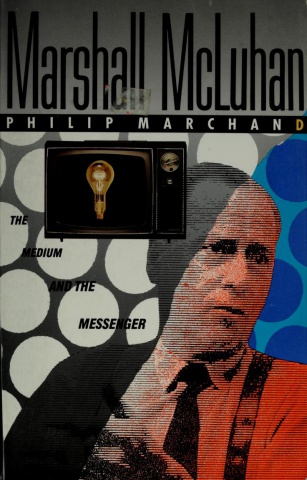Philip Marchand: Marshall McLuhan: The Medium and the Messenger (1989)
Filed under book | Tags: · advertising, biography, communication, mass media, media, media theory, print, radio, religion, technology, television

He was described as “the greatest put-on artist of all time” and even as the greatest intellectual pioneer since Freud. Bouncing back and forth between the quiet University of Toronto campus and the glitzy world of the New York media, McLuhan was surely the most unlikely prophet of the sixties, yet his work underlies any serious discussion of the effects of media on our lives. (from the back cover)
Publisher Ticknor & Fields, New York, 1989
ISBN 0899194850
320 pages
Review (Christopher Lehmann-Haupt, The New York Times Books, 1989)
Review (E. Hamilton, Canadian Literature, 2001)
Review (Robert McKenzie, IPCT, 1994)
Review (William H. Melody, Information, Communication & Society, undated)
PDF (50 MB, no OCR)
Comment (0)Le concept d’information dans la science contemporaine (1965) [French]
Filed under proceedings | Tags: · communication, computing, cybernetics, information, information theory, machine, mathematics, philosophy, science

“The proceedings from the Sixth Symposium at Royaumont in 1962 were titled Le concept d’information dans la science contemporaine [The Concept of Information in Contemporary Science] and were published three years later in Paris by Les Éditions de Minuit.
In attendance were Gilbert Simondon, Norbert Wiener, Martial Gueroult, Giorgio de Santillana, Lucien Goldmann, Benoit Mandelbrot, René de Possel, Jean Hyppolite, André Michel Lwoff, Abraham Moles, Ferdinand Alquié, Henryk Greniewski, Helmar Frank, Jiri Zeman, François Bonsack, Louis Couffignal, Albert Perez, Maurice de Gandillac, Ladislav Tondl, Gilles-Gaston Granger, and Stanislas Bellert, among others.
Simondon was a very active organizer and introduced Wiener. The collection is fascinating for a number of reasons; most striking, perhaps, is the fact that a prominent Marxist (Goldmann) and a brilliant mathematician (Mandelbrot) were given equal opportunity to talk philosophically about the concept of information. Mathematicians like Mandelbrot and Wiener were given the same stage as philosophers like Simondon and Hyppolite.
Some of the papers are pretty scientific, but most of them are not. What you get is a collection of papers given and discussed (the Q & As are included and are revealing) by some of the individuals who heavily influenced Deleuze and a number of other French philosophers. This is an incredibly revealing volume and I will eventually work hard to translate some of the papers that are included.
Simondon’s paper, ‘L’Amplification dans les processus d’information’, was not included in the proceedings (only the abstract is provided at the very end of the book, along with the topic of Wiener’s response to Simondon), but was published and is available in the collection of his papers titled Communication and Information: Courses and Conferences (La Transparence, 2010).” (from a blog post by Andrew Iliadis)
Publisher Les Éditions de Minuit, Paris, 1965
425 pages
via Andrew Iliadis, HT babyalanturing
Review: D. Gabor (The British Journal for the Philosophy of Science, 1966, EN).
PDF (36 MB, updated on 2021-3-28)
multiple formats (Internet Archive)
Hannah Weiner: Code Poems from The International Code of Signals for the Use of All Nations (1982)
Filed under artist publishing, poetry | Tags: · code, communication, poetry

“I am interested in exploring methods of communication that will be understood face to face or at any distance, regardless of language, country or planet or origin, by all sending and receiving.
For three years I have used the international code of signals to make poems and poetry events, because this code makes available and possible the translation of simultaneous equivalents:
- Flashing light (by Morse): abstract visual,
- Sound signaling (by Morse): abstact aural,
- Live semaphore: motion,
- Fixed semaphore: motion,
- Flag hoists: concrete visual,
- Radio: electronic,
- Words (including equivalent translations in seven different languages.
[..] The amount of information available has more than doubled since WW2. In the next ten years it will double again. How do we deal with it?
- Do we use more than the 5% of the brain now in use?
- Do we process quicker?
- Do we decode information more and put it in another form (not language) so that the present brain can handle it?
- Is there a change in the neural circuits of the brain?
[..] At the moment I am interested in exploring methods of communication through space; considering space as space fields or space solids; through great distances of space; through small distances, such as the space between the nucleus and the electrons of an atom; through distances not ordinarily related to the form of communication used. I am interested in doing this so that we may develop methods of communication that will be understood face to face, or at any distance, regardless of language, country, or planet of origin, by all sending and receiving. For me this implies an understanding of four, five, (and six?) dimensional space; of how what can be transmitted through this space; of how these special dimensions relate to different “states of consciousness” and to different neurological patterns (if any).”
Quoted from Weiner’s “Trans-Space Communication” statement (published in July 1969) written to accompany her performances of Code Poems.
Publisher Open Book Publications, Barrytown/New York, 1982
ISBN 0940170035
28 pages
via waskleist
Weiner at EPC Buffalo
Weiner at PennSound
PDF (no OCR)
Comment (0)
